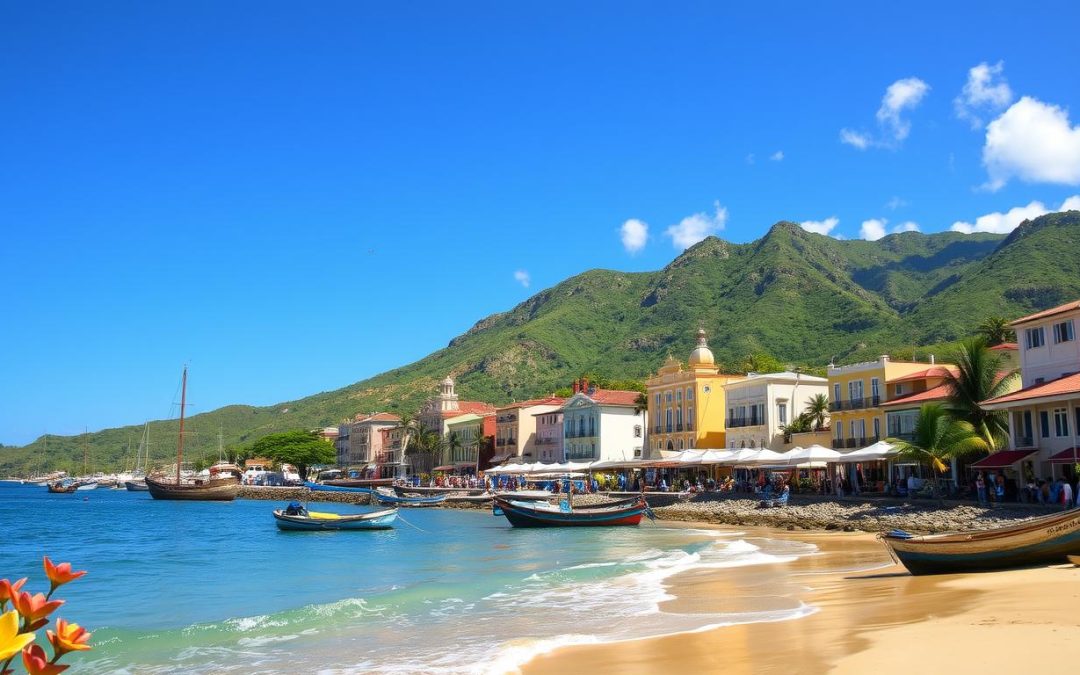Ever wondered about a hidden Caribbean gem? Cap-Haïtien, Haiti’s second-largest city, is a mix of stunning history and rich culture. It invites travelers to explore its amazing past and lively present.
Located on Haiti’s northern coast, Cap-Haïtien takes you back in time. Known as the “Paris of the Antilles,” it offers a rare look at Caribbean heritage. This city is a treasure trove of history and culture.
Cap-Haïtien is home to UNESCO World Heritage sites and beautiful colonial buildings. It’s an adventure that goes beyond what you might expect from tourism. Your journey through Haiti tourism begins here, showing a place that’s both complex and fascinating.
Key Takeaways
- Discover the historic “Paris of the Antilles”
- Experience unique Caribbean cultural heritage
- Explore UNESCO World Heritage sites
- Uncover Haiti’s rich colonial history
- Navigate an off-the-beaten-path destination
Introduction to Cap-Haïtien’s Rich Heritage
Welcome to Cap-Haïtien, a Caribbean gem full of history. It’s Haiti’s second-largest city, offering a peek into a rich past. In 2020, it celebrated its 350th year, showing its strength and cultural care.
The Paris of the Antilles
Cap-Haïtien was once called the “Paris of the Antilles.” It was known for its French-style buildings and culture. As the French Colony of Saint-Domingue’s capital from 1711 to 1770, it left a mark on architecture and culture.
Haiti’s Path to Independence
Cap-Haïtien was key in Haiti’s fight for freedom. It saw important moments in the quest for liberty. The city changed from a French colony to a symbol of freedom.
- Witnessed key independence battles
- Home to significant historic sites
- Birthplace of Haiti’s revolutionary movement
Modern Cap-Haïtien
Now, Cap-Haïtien is a cultural and economic hub in northern Haiti. Despite hurdles, it’s a lively spot for those into history and culture. It mixes old colonial charm with modern Haitian life, offering a unique visit.
“Cap-Haïtien is not just a city, it’s a living museum of Haitian history and culture.”
Cap-Haïtien’s streets and attractions invite you to see where history meets today. It’s a place where the past and present come together in a special way.
Getting to Cap-Haïtien and Transportation Options
Exploring Haiti tourism needs careful planning, especially for Cap-Haïtien. This city, Haiti’s second, offers unique Caribbean travel experiences. You’ll need to think about how to get there.
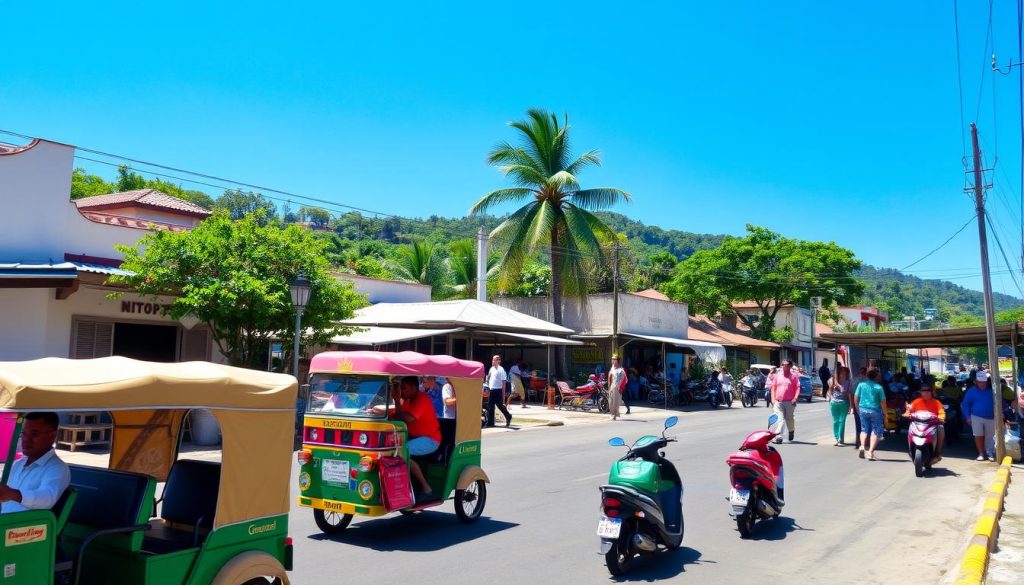
- Flights to Cap-Haïtien International Airport
- Bus services from the Dominican Republic
- Overland transportation via Caribe Tours
Traveling to Cap-Haïtien is an adventure. Flights are convenient but pricey. If you’re watching your budget, consider other options.
“Transportation in Haiti is about embracing flexibility and adventure.” – Caribbean Travel Expert
Transportation Costs Comparison
| Transportation Method | Estimated Cost | Travel Time |
|---|---|---|
| Direct Flight | $250-$400 | 1-2 hours |
| Bus from Dominican Republic | $30-$50 | 4-6 hours |
In Cap-Haïtien, you can use taxis, motorcycle taxis, and tuk-tuks. Always agree on prices first. Also, plan extra time for the city’s lively streets.
Caribbean travel tip: Book your bus ticket from Santo Domingo a day early. This way, you’ll get a spot and avoid last-minute issues.
Best Time to Visit and Weather Considerations
When planning your trip to Haiti, think about the weather. Cap-Haïtien has different seasons that can change your trip. Each season offers unique experiences.
The weather in Cap-Haïtien is tropical. It changes throughout the year, making some times better for a vacation.
Peak Tourist Seasons
The best time to visit is from November to March. During this time, you can expect:
- Dry and sunny weather
- Temperatures between 19°C and 28°C
- Great conditions for outdoor activities
Climate Patterns
Knowing Haiti’s weather is key to a great trip. The country has two main seasons:
| Season | Months | Characteristics |
|---|---|---|
| Dry Season | November-March | Sunny, minimal rainfall, peak tourism |
| Wet Season | April-October | Higher rainfall, fewer tourists, lush landscapes |
Local Events and Festivals
Make your trip to Haiti even better by attending local events:
- Carnival: February’s big cultural event
- Cap-Haïtien International Jazz Festival: January’s highlight
- Festival of the Holy Cross: May’s exciting event
Pro tip: Book early in peak seasons for the best deals.
Remember, August to October is hurricane season. Keep an eye on weather updates during this time.
The Magnificent Citadelle Laferrière
The Citadelle Laferrière sits atop Bonnet a L’Eveque mountain. It’s a top attraction in Cap-Haitian, Haiti. Built in 1805, it shows Haiti’s fight for freedom and its architectural skill.
This UNESCO World Heritage Site gives a deep look into Haiti’s fight for freedom. It’s the biggest fortress in the Americas. From its mountain spot, you see amazing views of the area.
“A monument that speaks volumes about resilience and national pride” – Haitian Historical Society
Exploring the Citadelle
- Massive stone walls stretching across the mountaintop
- Hundreds of preserved historical cannons
- Intricate architectural details showcasing 19th-century military engineering
- Stunning coastal and mountain vistas
You can get to the Citadelle by hiking or horseback riding. Both ways offer great views and a fun trip. The path takes you through beautiful Haitian scenery to the fortress.
For those who love history and culture, the Citadelle is more than a place to visit. It’s a strong symbol of Haiti’s fight for freedom and its identity.
Visitor Information
- Location: 17 miles south of Cap-Haïtien
- UNESCO Status: World Heritage Site since 1982
- Recommended Visit Duration: 2-3 hours
- Average Rating: 4.50/5 from visitors
Get ready for an amazing trip to a key historic site in the Caribbean. The Citadelle Laferrière is waiting for you!
Cap-Haïtien, Haiti: Best Things to Do – Top Picks
Explore the lively heart of Cap-Haïtien, filled with cultural experiences and amazing attractions. Your trip here will be an adventure that shows you the true Caribbean spirit.
Colonial Architecture Tours
Travel back in time with Cap-Haïtien’s colonial architecture. The city has high-roofed houses with intricate arched doors and charming overhanging balconies. These buildings remind you of New Orleans from long ago, perfect for photographers and history lovers.
- Take guided walking tours of historic neighborhoods
- Capture stunning photographs of French-inspired buildings
- Learn about architectural preservation efforts
Cultural Experiences
Dive into authentic Haitian culture with unique experiences. From Vodou ceremonies to local craft workshops, Cap-Haïtien reveals its rich heritage.
- Attend a traditional Vodou ceremony
- Participate in local cooking classes
- Explore artisan craft workshops
Local Markets and Shopping
Don’t miss the vibrant markets in Cap-Haïtien. The Iron Market (Marche au Fer) is a historical gem where you can find unique crafts and try local foods.
| Market | Specialty | Best Time to Visit |
|---|---|---|
| Iron Market | Handmade Crafts | Morning Hours |
| Local Artisan Market | Traditional Artwork | Weekend Mornings |
Experience Cap-Haïtien not just as a traveler, but as a cultural explorer discovering the soul of Haiti.
Exploring Sans-Souci Palace
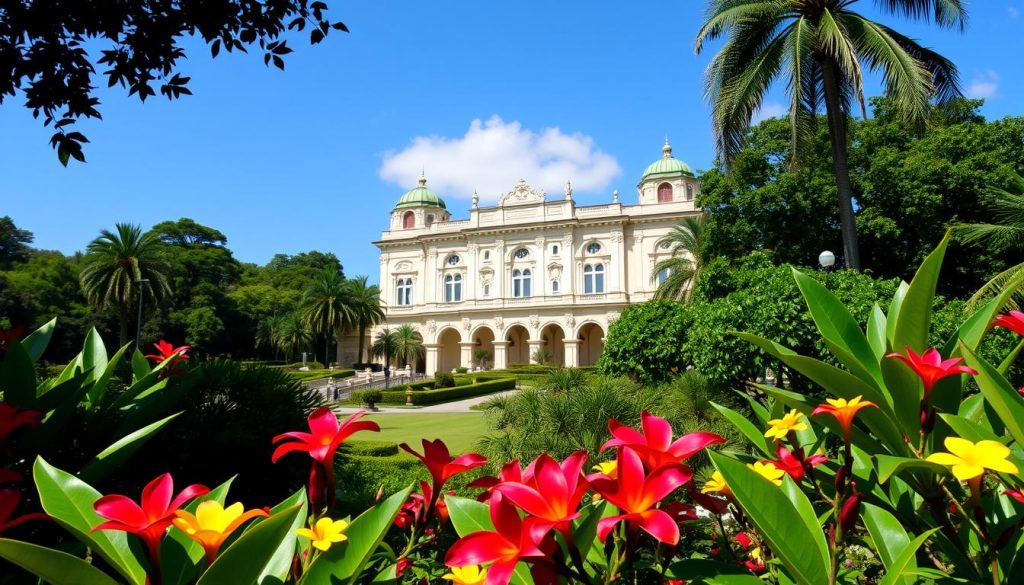
Discover the breathtaking Sans-Souci Palace, a top Cap-Haitian attraction. It shows Haiti’s rich history. This UNESCO World Heritage site takes you back to the early 19th century.
Built from 1810 to 1813 by King Henri Christophe, it was called the “Versailles of the Caribbean”. Its baroque architecture has Prussian design influences. This shows the grandeur of its time.
“A palace that speaks volumes about Haiti’s proud history and architectural brilliance” – Historical Preservation Society
- Constructed as a royal residence showcasing Haiti’s post-independence power
- Features intricate architectural details from baroque and Prussian design traditions
- Part of the historic trio including Citadelle and Milot Chapel
- Recognized as a critical historic site representing Haitian national pride
An 1842 earthquake damaged the palace, leaving ruins. Yet, its structures still inspire visitors. Walking through, you feel Haiti’s powerful past. The trip to Sans-Souci is through beautiful Haitian countryside, perfect for history lovers and cultural explorers.
| Palace Details | Historical Significance |
|---|---|
| Construction Period | 1810-1813 |
| Architectural Style | Baroque with Prussian influences |
| UNESCO Status | World Heritage Site |
| Original Purpose | Royal Residence of King Henri Christophe |
Whether you love history or are just curious, Sans-Souci Palace is unforgettable. It’s a journey through Haiti’s past. Get ready to be amazed by this iconic site that draws visitors worldwide.
Local Cuisine and Dining Experiences
Exploring Haitian cuisine is a tasty way to dive into the area’s rich culture. Cap-Haïtien’s food scene is a colorful mix of tastes. It shows the city’s varied history.
Traditional Haitian Dishes
Make sure to try these famous dishes in Cap-Haïtien:
- Griot: Crispy fried pork with tangy sauce
- Diri ak Pwa: Classic rice and beans
- Pikliz: Spicy pickled vegetable coleslaw
- Fresh seafood from the Caribbean
Best Restaurants in Cap-Haïtien
For real Haitian food, look for places that use local methods and fresh ingredients. Some spots offer both traditional and modern takes on classic dishes.
“Food is the heart of Haitian culture – every bite tells a story of resilience and creativity.”
Street Food Safety Tips
Street food is tempting, but stay safe with these tips:
- Choose vendors with lots of customers
- Look for clean food prep
- Go for cooked foods over raw
- Carry hand sanitizer
Try local Haitian coffee and Rhum Barbancourt for a full Cap-Haïtien food adventure.
Accommodation Options and Safety Considerations
Planning your trip to Cap-Haïtien in the Caribbean is important. You need to think about where to stay and how safe it is. The city has many places to stay, for every budget and taste.
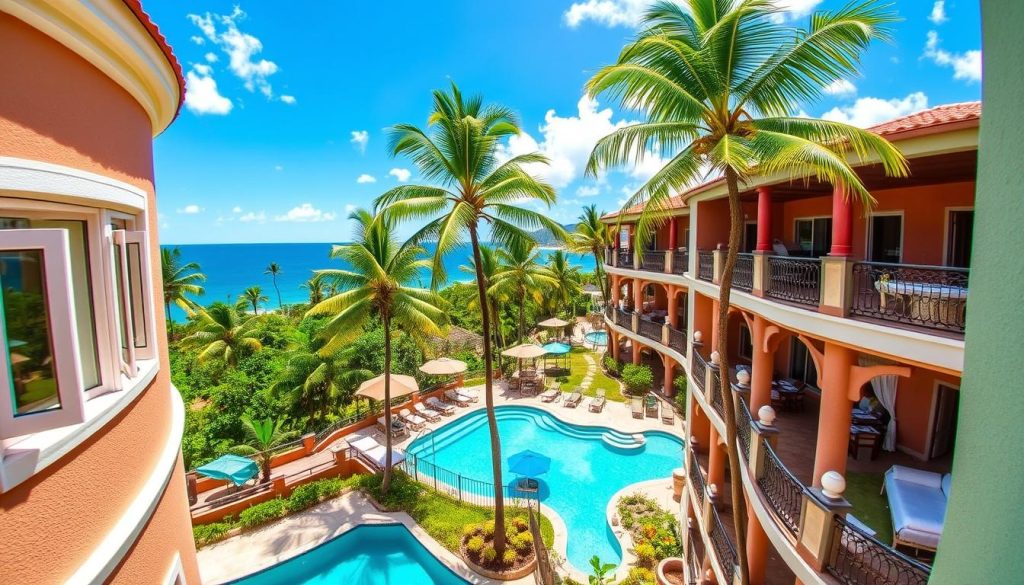
Look for a place that is safe and comfortable. The Satama Hotel is a great choice. It’s in the hills above the city and has modern comforts and beautiful views.
Accommodation Price Range
| Accommodation Type | Price Range (USD) | Amenities |
|---|---|---|
| Budget Guesthouses | $10 – $30 per night | Basic facilities, local experience |
| Mid-range Hotels | $30 – $70 per night | Better amenities, more comfort |
| Upscale Hotels (e.g., Satama) | $70 – $150 per night | Western-style amenities, panoramic views |
Safety Recommendations
- Choose accommodations in hillside areas for enhanced security
- Use hotel safes for valuable items
- Be aware of your surroundings
- Avoid displaying expensive jewelry or electronics
Safety Note: The U.S. Department of State has a Level 4 travel advisory for Haiti. But, locals say Cap-Haïtien is safer than Port-au-Prince. Always be careful and keep up with the latest news.
“Travel smart, stay aware, and enjoy the unique experience of Haiti tourism.” – Local Travel Expert
Choosing where to stay is key to a good trip. Do your homework, book early, and focus on safety and comfort in Cap-Haïtien.
Beaches and Natural Attractions
Cap-Haïtien is a mix of coastal beauty and rugged nature. The city’s beaches are not perfect, but the areas around it are full of natural wonders.
Exploring Haiti’s beaches can take you to amazing spots near Cap-Haïtien. The area has different landscapes for those who love to relax or seek adventure.
Coastal Discoveries
Cap-Haïtien’s beaches are safe with caution, but nearby spots are even better. Here are some top places for outdoor fun:
- Gelee Beach: The longest sandy stretch in Haiti
- Kokoye Beach: Perfect for swimming and snorkeling
- Ils-a-Rat Beach: Exceptional marine biodiversity
Mountain Perspectives
The mountains around Cap-Haïtien offer great views and hiking trails. Morne La Visite is a must-see for its stunning views of the Caribbean.
| Location | Activities | Best Season |
|---|---|---|
| Pic de la Selle | Hiking, Photography | November-March |
| Citadelle Laferrière | Historical Exploration | Dry Season |
| Bassin-Bleu Waterfalls | Swimming, Nature Walk | November-April |
Natural Landmarks
Haiti’s nature is more than just beaches. The Artibonite River Valley is a lush area known as the “breadbasket.” It’s a favorite among adventure lovers.
“Haiti’s natural beauty is a hidden gem waiting to be discovered by intrepid travelers.” – Local Tourism Expert
Always be safe by traveling with local guides and caring for the environment. Your adventures in Cap-Haïtien will show you a side of Haiti most tourists miss.
Cultural Etiquette and Travel Tips
Exploring Cap-Haïtien means learning about Haiti’s unique culture. You’ll find joy in respecting traditions and connecting with locals.
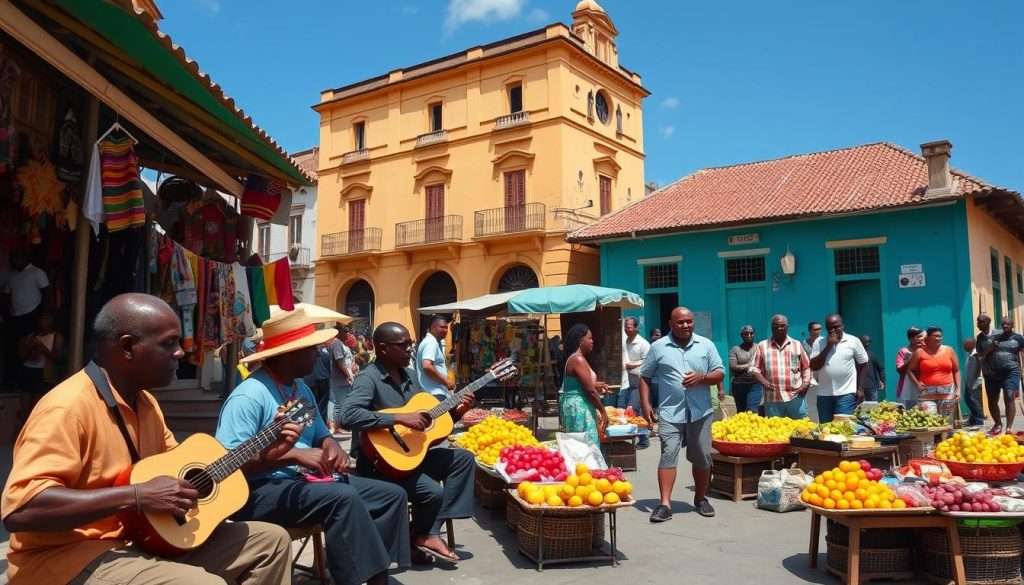
Visiting Haiti? Be mindful of cultural norms. Haitians love personal interactions and value respect for their customs. Here are some tips for your journey:
- Learn basic Creole phrases like bonjou (hello) and mèsi (thank you)
- Dress modestly, especially in rural areas and religious sites
- Always ask permission before taking photographs
- Be patient with local schedules and service variations
“Approaching Haiti with an open mind reveals a rich cultural landscape beyond stereotypes.” – Local Travel Guide
Haiti tourism offers deep cultural experiences. Here are some insights:
| Cultural Practice | Significance | Participation Rate |
|---|---|---|
| Vodou Ceremonies | Spiritual and artistic expression | 50% of population |
| Krik-Krak Storytelling | Community narrative tradition | 75% participation |
| Konbit Agricultural Practice | Communal cooperation | 99.9% in rural areas |
Grasping these cultural nuances will turn your Haiti trip into a rich cultural journey.
Conclusion
As your Haiti tourism adventure comes to an end, Cap-Haïtien shows itself as a place that surprises. This city gives travelers a real Caribbean feel, unlike the usual tourist spots. You’ll see the true spirit of Haitian culture through its lively streets and historic sites.
The “Best Things to Do – Top Picks” in Cap-Haïtien are more than just sights. You’ll be amazed by the Citadelle Laferrière and the lively markets. The city’s history and friendly people make your trip unforgettable.
For those looking for a real cultural experience, Cap-Haïtien is perfect. Despite its challenges, it offers a unique view of Haiti’s beauty. Your visit here will connect you deeply with the community, showing you true Haitian hospitality.
Cap-Haïtien might not be a typical tourist place, but it’s a journey that changes you. Bring your sense of adventure, respect for local culture, and an open mind. The experiences you’ll have here will be unforgettable, leaving you with stories and memories for a lifetime.
The above is subject to change.
Check back often to TRAVEL.COM for the latest travel tips and deals.
